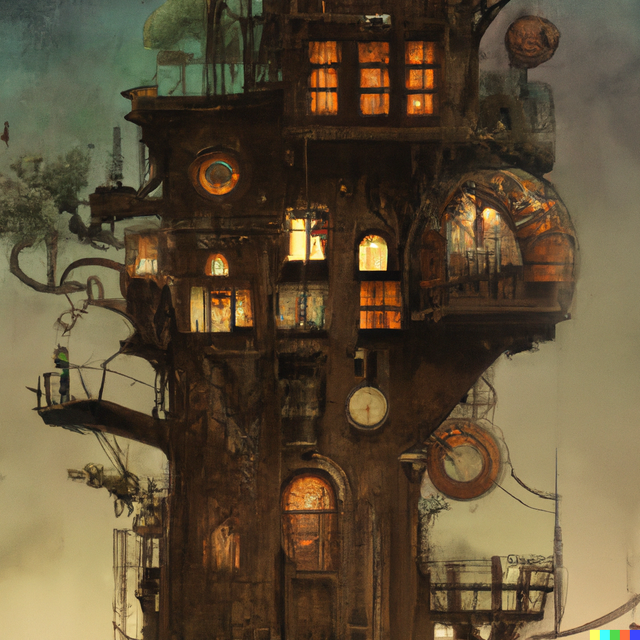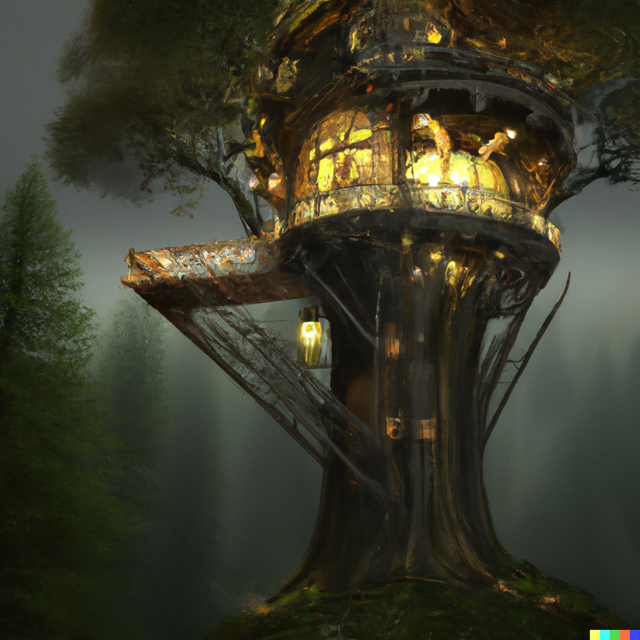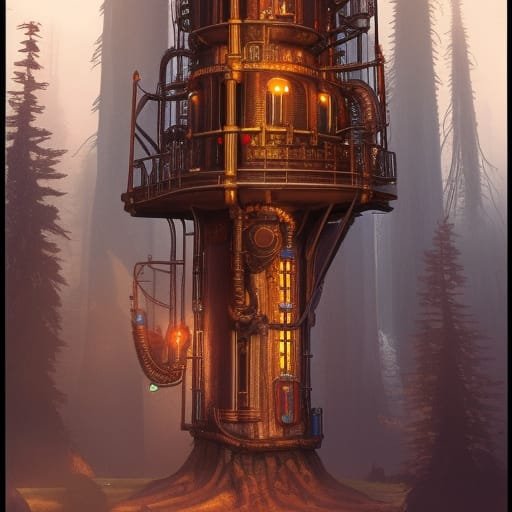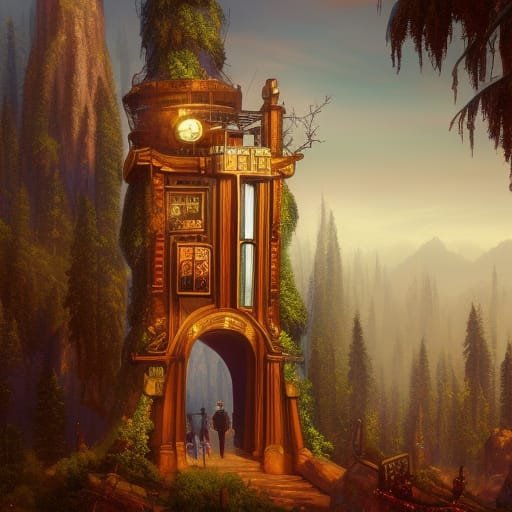The Tree-Dwellers of Rohnerville
-The Tree-Dwellers of Rohnerville-
The forest was alive with the sound of saws and hammers. High above the ground, artisans worked tirelessly to create a town unlike any other. Nestled in the ancient old-growth redwood trees of Humboldt County, California, the town of Rohnerville was a utopia of artistry and engineering. Every treehouse was a masterpiece, crafted with precision and care to create a network of homes that seemed to grow organically from the trees themselves. The artisans who lived and worked in the town were a unique breed, with a deep love and respect for the forest that surrounded them. And as the sun set behind the towering trees, casting long shadows across the town, the people of Rohnerville gathered to marvel at the beauty of their home, and to give thanks to the forest that had made it all possible.
The artisans of Rohnerville were masters of steam technology, using it to create a world that blended the old with the new. In their hands, gears and pistons were transformed into intricate machines, powered by steam and fueled by ingenuity. They built lifts that ran up and down the trunks of the trees, powered by pulleys and cogs, and bridges that spanned the forest canopy with a grace that defied gravity. They used steam-powered saws and drills to shape the wood into the most intricate designs, and created ingenious water collection systems that drew the life-giving liquid from the rain that fell on the leaves above. And as they worked, they added their own personal touches to each creation, leaving behind a legacy of beauty and innovation that would inspire generations to come.
The treehouses were connected by an intricate network of rope and wood bridges, crafted with precision and care to withstand the strong winds that often blew through the forest. It was a magical place, a true utopia, where the people could bask in the beauty of the natural world and enjoy the simplicity of life.
The artisans of Rohnerville had a reverence for the old-growth redwood trees that surrounded their town. They saw them as living, breathing entities, not just objects to be used for building. They knew that they could not simply chop down the trees to build their homes. Instead, they had to work with the trees, to find a way to make their dwellings a part of the forest.
And so, they devised a plan. They would build their treehouses into the trees, using the branches and trunks as a foundation. They would not cut down a single tree, but instead work with them to create a sustainable living environment. They spent years studying the trees, learning how they grew, how they adapted to the changing seasons, and how they interacted with the other plants and animals in the forest.
They began by carefully selecting the trees that would serve as the foundation for their homes. They looked for trees that were sturdy, with strong branches and a thick trunk. They then used ropes and pulleys to lift the building materials into the trees, working with a careful precision to avoid damaging the branches and bark.
They built the treehouses high up in the trees, creating a network of homes that looked like something out of a fairy tale. They used the branches of the trees as support beams, building platforms and walkways that would be as sturdy as any building on the ground. They crafted each treehouse with care and attention to detail, creating spaces that were not just functional, but beautiful as well.
And so, the people of Rohnerville lived high up in the trees, in homes that were a part of the forest. They woke up to the sounds of birds singing and the rustling of leaves in the wind. They felt the gentle sway of the trees beneath their feet, and knew that they were a part of something greater than themselves. They had found a way to live in harmony with the natural world, and they were proud of the homes they had built.
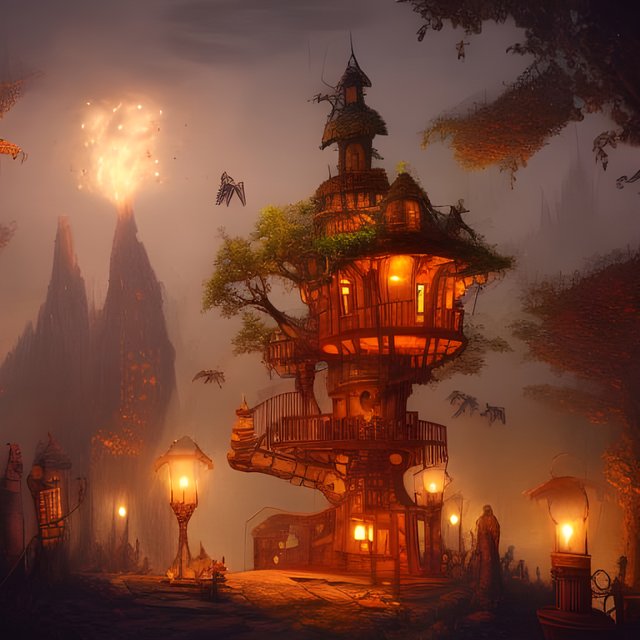
But, as with all things in life, nothing stays perfect forever. The Eel River Valley, which surrounded the forest, was notorious for the horrible floods that routinely swept through it, leaving nothing but destruction in their wake. It was a constant reminder that the people had to respect the power of nature, and that they were never truly safe.
So, the people of Rohnerville devised a plan to dam the river. They summoned the spirit of the great mother beaver, and put her to work stacking logs. For weeks, they toiled from dawn until dusk, driven by a collective desire to protect their beloved town from the wrath of the river. They worked so hard that they even named the dam after the hardest worker, Ol' Mother Beaver.
The mother beaver spirit was a powerful and capricious being, summoned by the villagers of Rohnerville only in times of dire need. Her help was never guaranteed, and even when she did lend her aid, she was a difficult presence to deal with. She demanded offerings of rare and valuable objects, and her mood could change in an instant, making it difficult to predict how she would react to any given situation.
Despite these challenges, the villagers of Rohnerville relied on the mother beaver spirit, knowing that without her help, they would be helpless against the floods that ravaged their land. They were careful to follow her rules, making the necessary sacrifices and performing the required rituals to keep her satisfied. But even the most careful and respectful villager could find themselves on the wrong side of the mother beaver's temper, and her punishments were swift and severe.
Over time, the relationship between the villagers and the mother beaver spirit became more and more strained. The villagers resented her constant demands and unpredictable moods, and they began to whisper among themselves about ways to rid themselves of her influence. But the mother beaver was always watching, always listening, and those who spoke ill of her soon found themselves facing her wrath.
Despite the challenges and dangers, the villagers of Rohnerville continued to rely on the mother beaver spirit, knowing that they had no other choice. They hoped that one day, they would be able to repay the ancient debt that bound them to her, and that they would be free from her influence forever. But for now, they continued to live with one foot in the supernatural world, never quite sure what fate would bring them next.
The carpenter of Rohnerville, Tom, was a man of great skill and determination, who had overcome a terrible accident that had left him without an arm. But he refused to let his disability get in the way of his craft, and so he did something that others might find shocking: he had a steam-powered chainsaw surgically attached to his arm. The chainsaw was a wonder of engineering, with razor-sharp teeth and a steam-powered motor that hummed with energy. And with this amazing tool, the carpenter could do things that others could only dream of, slicing through wood with ease and precision. He was a legend in the town, revered for his skill and admired for his bravery, and whenever he worked, all eyes were on him as he crafted wonders with his steam-powered arm.
He was a master of his craft, with an eye for detail and a steady hand that could make even the most complex of designs come to life. Tom was also an experienced climber, able to navigate the ancient redwood trees with ease.
Tom's workmanship was unparalleled. He could carve intricate designs into the wood, creating patterns that seemed to come to life in the sunlight. He knew just how much weight each branch could hold, and could build a treehouse that would stand strong in the face of the fiercest winds. He took pride in his work, and his dedication showed in every project he undertook.
As a climber, Tom was fearless. He had spent years mastering the art of tree climbing, learning how to move through the branches with speed and agility. He had a natural sense of balance, and could navigate even the thinnest of branches with ease. He knew the forest like the back of his hand, and could find his way to any treehouse in the town without a second thought.
Tom's reputation as a carpenter and climber was well-known throughout the town. People would come from miles around to seek out his services, and he never disappointed. His treehouses were the envy of the forest, with intricate designs and breathtaking views. And as a climber, he was in a league of his own, able to move through the trees with a grace that seemed almost supernatural.
For a while, everything was going well. The dam held back the waters, and the people of Rohnerville breathed a sigh of relief. They felt that they had achieved something great, and that they had shown the power of human ingenuity and determination. But, as it turned out, they had underestimated the power of the river. It was a living, breathing organism, with its own will and desires.
The people of Rohnerville had always known that the forest was both their home and their greatest foe. The ancient redwoods that surrounded them were a source of pride and wonder, but also a threat, as the floods that swept through the Eel river valley could be deadly. And so, when the winds began to howl and the sky darkened, the people of Rohnerville knew that a terrible storm was coming.
As the first drops of rain fell, the people sprang into action, battening down the hatches and preparing for the worst. They checked the ropes and bridges that connected the treehouses, making sure that everything was secure and ready for the onslaught. And when the storm hit in earnest, the people huddled together in their homes, listening to the roar of the wind and the crash of the rain.
For three days and three nights, the storm raged on, tearing at the trees and flooding the valley below. But the people of Rohnerville had planned for this, and their homes were built to withstand even the fiercest of storms. The bridges held, the ropes held, and the treehouses remained strong, their wooden walls creaking but not giving way.
As the storm raged on, the people of Rohnerville were grateful for the carpenter and his skill. He had spent the days before the storm reinforcing the bridges and ropes that connected the treehouses, and his craftsmanship had held fast, saving many lives. But as the storm reached its height, the carpenter had ventured out to check on a family that had been cut off by a fallen tree. It was a dangerous mission, and nobody would have blamed him for waiting until the storm passed, but the carpenter was a hero, and he knew that he had to help.
It was a treacherous journey, with the wind howling and the rain lashing at his face, but the carpenter was determined to reach the family. He climbed and swung from branch to branch, using his steam-powered chainsaw to cut through the fallen trees that blocked his way. And finally, after hours of effort, he reached the family's treehouse, battered but alive.
But as the carpenter began to make his way back, disaster struck. A tree that had been weakened by the storm gave way, and the carpenter was caught in its grip. The people of Rohnerville heard his cry for help, and they rushed to his aid, but it was too late. The carpenter of Rohnerville had given his life for his community, and he was mourned by all who knew him.
And when the storm finally passed, the people emerged from their homes, blinking in the bright sunlight. The forest around them was changed, with trees fallen and rivers raging, but parts of Rohnerville remained. The people were battered and bruised, but they were alive. And as they looked around at the beauty and the power of the forest, they knew that they would never leave this place, for it was their home, and their life.
It was a scene straight out of a disaster movie, and the people of Rohnerville were not amused. They had worked so hard, summoned the spirit of a beaver, and built a dam. A dam! They should have known that the river would not be so easily tamed. It was like trying to tame a wild horse, but with logs and beaver magic.
The once-beautiful forest was now a wasteland. The old-growth redwoods, which had stood for centuries, were now broken and uprooted. The people of Rohnerville were scattered, broken, and defeated. They had learned a terrible lesson, one that they would never forget. They had underestimated the power of nature, and they had paid the ultimate price. It was a price that they felt was too high, but at least they could now say that they had a great story to tell.
And so, the utopian dream of Rohnerville was shattered, but at least the people had a new story to tell. A story of a beaver, a dam, and a flood. A story of hubris and the consequences of underestimating the power of nature. It was a story that they would tell their children and their children's children for generations to come.
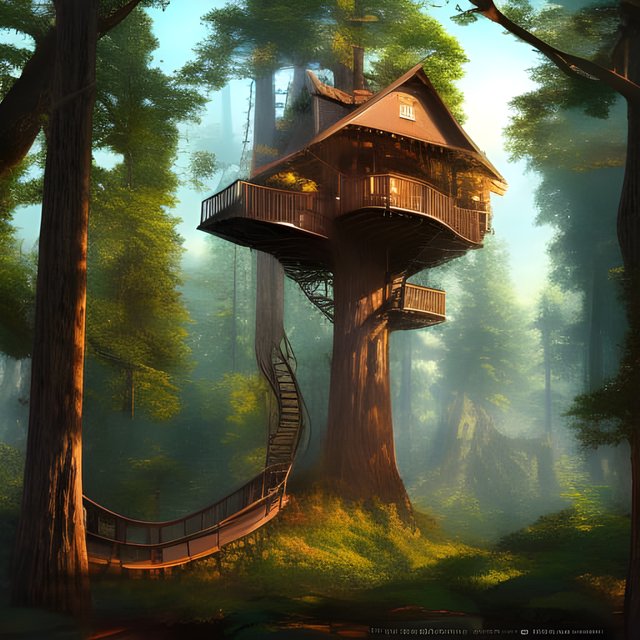
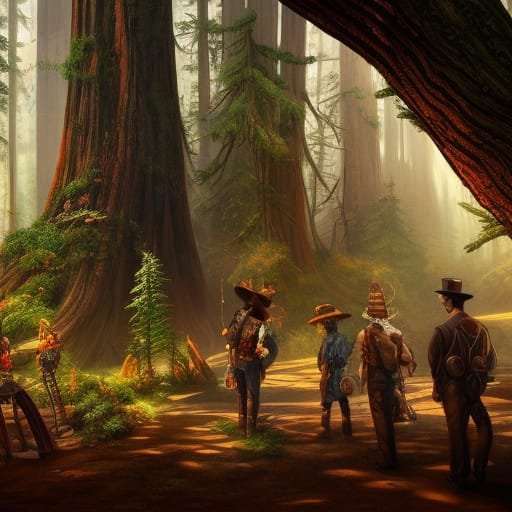
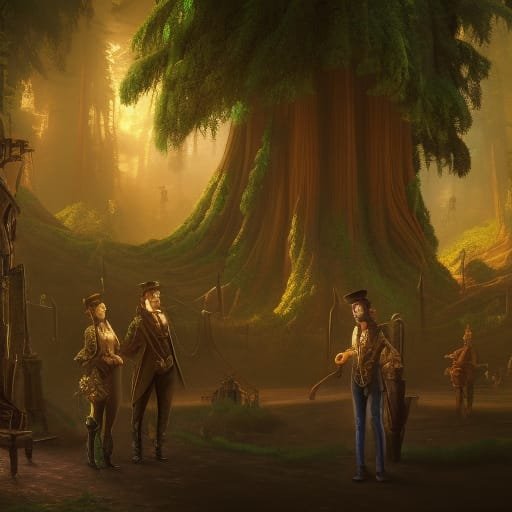
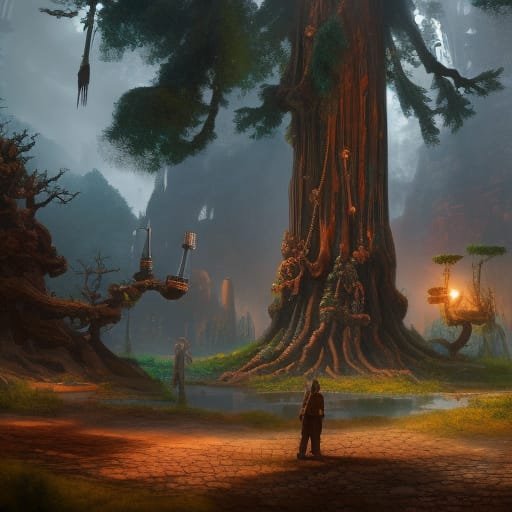





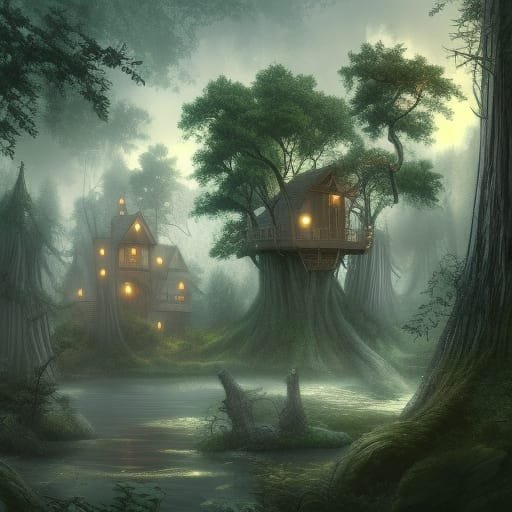



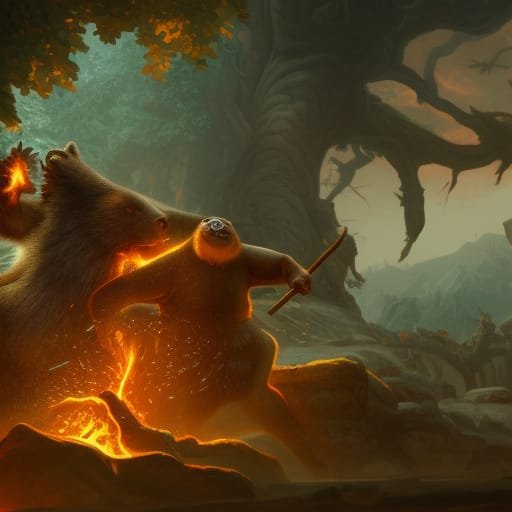

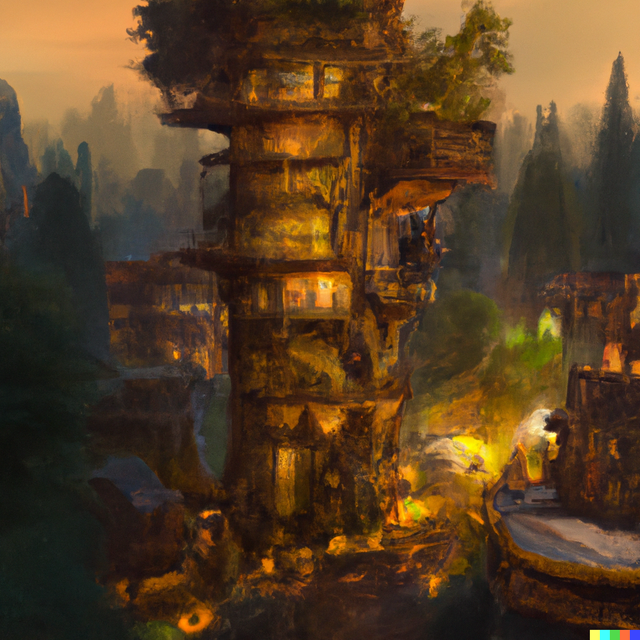


![[s_944876180]-[gs_7]-[is_30]-steampunk treehouse village in the giant redwood trees.jpeg](https://steemitimages.com/640x0/https://cdn.steemitimages.com/DQmfKVNmqkyFNzg2iYEGELGsGm3kC4qaPq3pPzN1HLfEuyJ/[s_944876180]-[gs_7]-[is_30]-steampunk%20treehouse%20village%20in%20the%20giant%20redwood%20trees.jpeg)
